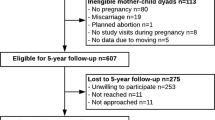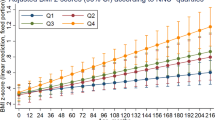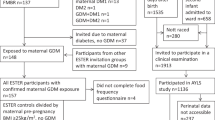Abstract
BACKGROUND/OBJECTIVES:
Animal models have demonstrated that maternal overnutrition during pregnancy influences offspring adiposity. Few human studies of normal pregnancy have replicated these findings. We examined the association between child body mass index at age 5 years and maternal nutrient intake during pregnancy and 5 years postpartum.
SUBJECTS/METHODS:
Five-year-old children (n=585) and their mothers were recruited during pregnancy from two maternity hospitals in Ireland. Data are from the Lifeways Cross-Generation Cohort study with detailed dietary information obtained during pregnancy and postpartum using a food frequency questionnaire. Nutrient intake was adjusted for energy intake (EI) and expressed in quartiles. Heights and weights were measured when the children were aged 5 years. We performed multivariate logistic regression analyses to examine the independent associations of macronutrients (protein, fat and carbohydrate) and their components (saturated fatty acid (SFA)/monounsaturated fatty acid/polyunsaturated fatty acid and sugar/starch) with child overweight/obesity. Associations were examined for nutrient intake during pregnancy (T1), at 5 years postpartum (T2) and the change in nutrient intake between T1 and T2.
RESULTS:
Total mean (s.d.) EI was significantly higher during pregnancy (2548±1239 kcal) than 5 years postpartum (2084±718 kcal). Increased odds of overweight/obesity were found in mothers with higher intakes of sugar at T1 (Q4 odds ratio (OR): 4.57, 95% confidence interval (CI): 1.01–20.69) and high intakes of SFA at T2 (Q4 OR: 3.35, 95% CI: 0.97–11.57). Mothers with persistently high intakes of SFA and those who reduce their sugar intake between T1 and T2 were more likely to have overweight/obese children.
CONCLUSION:
Maternal prenatal sugar and pre/postnatal SFA was associated with offspring adiposity.
This is a preview of subscription content, access via your institution
Access options
Subscribe to this journal
Receive 12 print issues and online access
$259.00 per year
only $21.58 per issue
Buy this article
- Purchase on Springer Link
- Instant access to full article PDF
Prices may be subject to local taxes which are calculated during checkout

Similar content being viewed by others
References
King JC . Physiology of pregnancy and nutrient metabolism. Am J Clin Nutr 2000; 71: 1218S–1225S.
Jackson AA, Robinson SM . Dietary guidelines for pregnancy: a review of current evidence. Public Health Nutr 2001; 4: 625–630.
McMillen IC, Robinson JS . Developmental origins of the metabolic syndrome: prediction, plasticity, and programming. Physiol Rev 2005; 85: 571–633.
Poston L . Gestational weight gain: influences on the long-term health of the child. Curr Opin Clin Nutr Metab Care 2012; 15: 252–257.
Brion M-JA, Ness AR, Rogers I, Emmett P, Cribb V, Davey Smith G et al. Maternal macronutrient and energy intakes in pregnancy and offspring intake at 10 y: exploring parental comparisons and prenatal effects. Am J Clin Nutr 2010; 91: 748–756.
Ainge H, Thompson C, Ozanne SE, Rooney KB . A systematic review on animal models of maternal high fat feeding and offspring glycaemic control. Int J Obes (Lond) 2011; 35: 325–335.
Donahue SM, Rifas-Shiman SL, Gold DR, Jouni ZE, Gillman MW, Oken E . Prenatal fatty acid status and child adiposity at age 3 y: results from a US pregnancy cohort. Am J Clin Nutr 2011; 93: 780–788.
Deierlein AL, Siega-Riz AM, Chantala K, Herring AH . The association between maternal glucose concentration and child BMI at age 3 years. Diabetes Care 2011; 34: 480–484.
O'Mahony D, Fallon UB, Hannon F, Kloeckner K, Avalos G, Murphy AW et al. The Lifeways Cross-Generation Study: design, recruitment and data management considerations. Ir Med J 2007; 100 (Suppl 8), 3–6.
Riboli E, Elmstahl S, Saracci R, Gullberg B, Lindgarde F . The Malmo Food Study: validity of two dietary assessment methods for measuring nutrient intake. Int J Epidemiol 1997; 26: S161.
Bingham SA, Gill C, Welch A, Cassidy A, Runswick SA, Oakes S et al. Validation of dietary assessment methods in the UK arm of EPIC using weighed records, and 24-hour urinary nitrogen and potassium and serum vitamin C and carotenoids as biomarkers. Int J Epidemiol 1997; 26 (Suppl 1), S137–S151.
Harrington J . Validation of a Food Frequency Questionnaire as a tool for assessing nutrient intake (MA Thesis). National University of Ireland Galway: Galway, 1997.
Morgan K, McGee H, Watson D, Perry I, Barry M, Shelley E et al SLÁN 2007: Survey of Lifestyle, Attitudes & Nutrition in Ireland. Main Report. Department of Health and Children: Dublin, 2008.
Kelleher CC, Nic Gabhainn S, Friel S, Corrigan H, Nolan G, Sixsmith J et al The National Health and Lifestyle Surveys: Survey of lifestyle, Attitudes and Nutrition (SLAN) and the Irish Health Behaviours in School-aged Children Survey (HBSC). National University of Ireland: Galway, 2003.
Friel S, Nic Gabhainn S, Kelleher CC . The National Health and Lifestyle Surveys: Survey of lifestyle, attitudes and nutrition (SLAN) and the Irish health behaviour in school-aged children survey (HBSC). National University of Ireland: Galway, 1999.
Murrin CM . Maternal factors during pregnancy contributing to early life risk of childhood obesity (PhD Thesis). University College Dublin: Dublin, 2011.
Food Standards Agency. Mc Cance and Widdowson's The Composition of Foods. Royal Society of Chemistry: Cambridge, 2002.
Schofield WN . Predicting basal metabolic rate, new standards and review of previous work. Hum Nutr Clin Nutr 1985; 39 (Suppl 1), 5–41.
Prentice AM, Spaaij CJ, Goldberg GR, Poppitt SD, Van Raaij JM, Totton M et al. Energy requirements of pregnant and lactating women. Eur J Clin Nutr 1996; 50: S82–S110. discussion S110–111.
Black AE . Critical evaluation of energy intake using the Goldberg cut-off for energy intake:basal metabolic rate. A practical guide to its calculation, use and limitations. Int J Obes Relat Metab Disord 2000; 24: 1119–1130.
Black AE, Goldberg GR, Jebb SA, Livingstone MB, Cole TJ, Prentice AM . Critical evaluation of energy intake data using fundamental principles of energy physiology: 2. Evaluating the results of published surveys. Eur J Clin Nutr 1991; 45: 583–599.
Goldberg GR, Black AE, Jebb SA, Cole TJ, Murgatroyd PR, Coward WA et al. Critical evaluation of energy intake data using fundamental principles of energy physiology: 1. Derivation of cut-off limits to identify under-recording. Eur J Clin Nutr 1991; 45: 569–581.
Cogill B . Anthropometric Indicators Measurement Guide. Food and Nutrition Technical Assistance Project: Washington, D.C., 2003.
World Health Organisation. STEPwise approach to chronic disease risk factor surveillance (STEPS). WHO Non-communicable Diseases and Mental Health; Training and Practical Guide. Section 3. Guide to Physical Measurements (Step 2) 2006; 1–14.
Cole T, Bellizzi M, Flegal K, Dietz W . Establishing a standard definition for child overweight and obesity worldwide: international survey. BMJ 2000; 320: 1240–1243.
Shrivastava A, Murrin C, Sweeney MR, Heavey P, Kelleher CC . Familial inter-generational and maternal aggregation patterns in nutrient intakes in the Lifeways Cross-Generation Cohort Study. Public Health Nutr 2012; 13: 1–11.
Khan IY, Dekou V, Douglas G, Jensen R, Hanson MA, Poston L et al. A high-fat diet during rat pregnancy or suckling induces cardiovascular dysfunction in adult offspring. Am J Physiol Regul Integr Comp Physiol 2005; 288: R127–R133.
Tamashiro KLK, Terrillion CE, Hyun J, Koenig JI, Moran TH . Prenatal stress or high fat diet increases susceptibility to diet-induced obesity in rat offspring. Diabetes 2009; 58: 1116–1125.
Howie GJ, Sloboda DM, Kamal T, Vickers MH . Maternal nutritional history predicts obesity in adult offspring independent of postnatal diet. J Physiol 2009; 587: 905–915.
Das UN . Perinatal nutrition and obesity. Br J Nutr 2008; 99: 1391–1392.
Dabelea D, Hanson RL, Lindsay RS, Pettit DJ, Imperatore G, Gabir MM et al. Intrauterine exposure to diabetes conveys risks for type 2 diabetes and obesity: a study of discordant sibships. Diabetes 2000; 49: 2208–2211.
Hillier TA, Pedula KL, Schmidt MM, Mullen JA, Charles MA, Pettitt DJ . Childhood obesity and metabolic imprinting: the ongoing effects of maternal hyperglycemia. Diabetes Care 2007; 30: 2287–2292.
HAPO. Hyperglycemia and Adverse Pregnancy Outcome (HAPO) Study: associations with neonatal anthropometrics. Diabetes 2009; 58: 453–459.
Pirkola J, Pouta A, Bloigu A, Hartikainen AL, Laitinen J, Jarvelin MR et al. Risks of Overweight and abdominal obesity at age 16 years associated with prenatal exposures to maternal prepregnancy overweight and gestational diabetes mellitus. Diabetes Care 2010; 33: 1115–1121.
Lawlor D, Fraser A, Lindsay R, Ness A, Dabelea D, Catalano P et al. Association of existing diabetes, gestational diabetes and glycosuria in pregnancy with macrosomia and offspring body mass index, waist and fat mass in later childhood: findings from a prospective pregnancy cohort. Diabetologia 2010; 53: 89–97.
Sermer M, Naylor CD, Gare DJ, Kenshole AB, Ritchie JW, Farine D et al. Impact of increasing carbohydrate intolerance on maternal-fetal outcomes in 3637 women without gestational diabetes. The Toronto Tri-Hospital Gestational Diabetes Project. Am J Obstet Gynecol 1995; 173: 146–156.
Scholl TO, Sowers M, Chen X, Lenders C . Maternal glucose concentration influences fetal growth, gestation, and pregnancy complications. Am. J. Epidemiol 2001; 154: 514–520.
Mello G, Parretti E, Cioni R, Lucchetti R, Carignani L, Martini E et al. The 75-gram glucose load in pregnancy. Diabetes Care 2003; 26: 1206–1210.
Langley-Evans S . Pregnancy. In: Langley-Evans S (ed). Nutrition: A Lifespan Approach 1st edn. Wiley-Blackwell: Oxford. pp 66–67, 2009.
Fraser RB, Ford FA, Lawrence GF . Insulin sensitivity in third trimester pregnancy. A randomized study of dietary effects. Br J Obstet Gynaecol 1988; 95: 223–229.
Deierlein AL, Siega-Riz AM, Herring A . Dietary energy density but not glycemic load is associated with gestational weight gain. Am J Clin Nutr 2008; 88: 693–699.
Bayol SA, Farrington SJ, Stickland NC . A maternal 'junk food' diet in pregnancy and lactation promotes an exacerbated taste for 'junk food' and a greater propensity for obesity in rat offspring. Br J Nutr 2007; 98: 843–851.
McGowan CA, McAuliffe FM . The influence of maternal glycaemia and dietary glycaemic index on pregnancy outcome in healthy mothers. Br J Nutr 2010; 104: 153–159.
Lutomski JE, van den Broeck J, Harrington J, Shiely F, Perry IJ . Sociodemographic, lifestyle, mental health and dietary factors associated with direction of misreporting of energy intake. Public Health Nutr 2011; 14: 532–541.
Rogers I, Emmett P . Diet during pregnancy in a population of pregnant women in South West England. ALSPAC Study Team. Avon Longitudinal Study of Pregnancy and Childhood. Eur J Clin Nutr 1998; 52: 246–250.
Nelson M . The validation of dietary questionnaire. In: Margretts BM, Nelson M (eds). Design Concepts in Nutritional Epidemiology. Oxford University Press: New York. pp 266–297, 1997.
Acknowledgements
The Lifeways Cross-Generation Cohort Study is funded by the Irish Health Research Board and is overseen by an inter-disciplinary steering group. This study was funded by the Irish Health Research Board.
Author information
Authors and Affiliations
Consortia
Corresponding author
Ethics declarations
Competing interests
The authors declare no conflict of interest.
Rights and permissions
About this article
Cite this article
Murrin, C., Shrivastava, A., Kelleher, C. et al. Maternal macronutrient intake during pregnancy and 5 years postpartum and associations with child weight status aged five. Eur J Clin Nutr 67, 670–679 (2013). https://doi.org/10.1038/ejcn.2013.76
Received:
Revised:
Accepted:
Published:
Issue Date:
DOI: https://doi.org/10.1038/ejcn.2013.76
Keywords
This article is cited by
-
Trajectories of dietary patterns from pregnancy to 12 years post-pregnancy and associated maternal characteristics: evidence from the Avon Longitudinal Study of Parents and Children
European Journal of Nutrition (2023)
-
The influence of birthweight and breastfeeding status on BMI outcome at first year of primary school: a retrospective study of an Irish child cohort
European Journal of Pediatrics (2023)
-
Macronutrient intake during pregnancy in women with a history of obesity or gestational diabetes and offspring adiposity at 5 years of age
International Journal of Obesity (2021)
-
Maternal dietary quality, inflammatory potential and childhood adiposity: an individual participant data pooled analysis of seven European cohorts in the ALPHABET consortium
BMC Medicine (2021)
-
Associations between a maternal healthy lifestyle score and adverse offspring birth outcomes and childhood obesity in the Lifeways Cross-Generation Cohort Study
International Journal of Obesity (2020)



